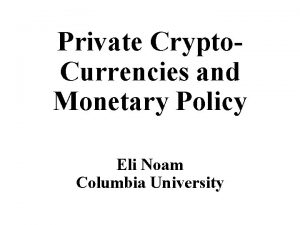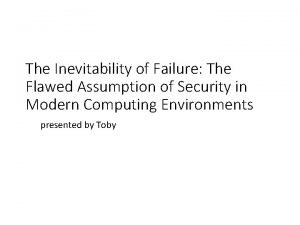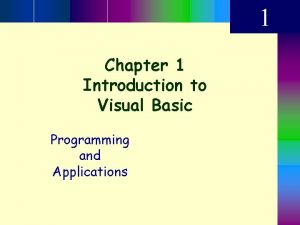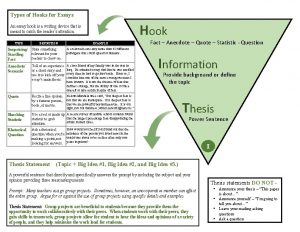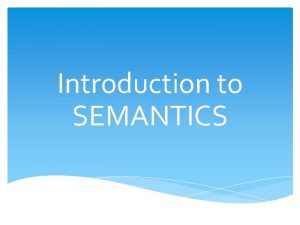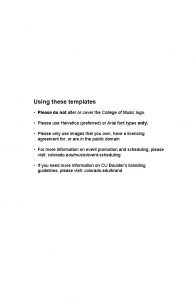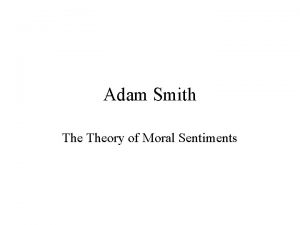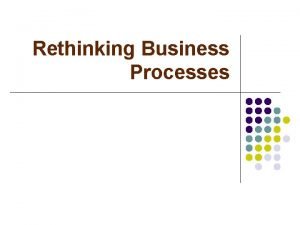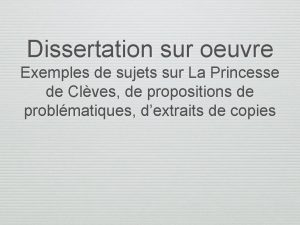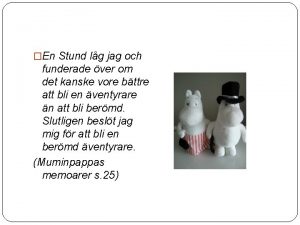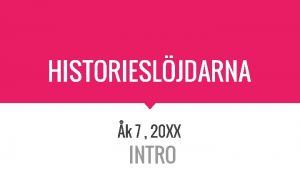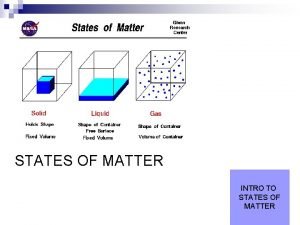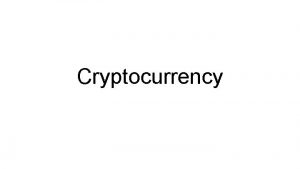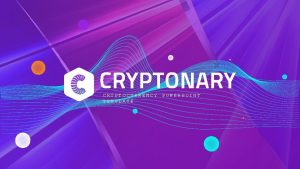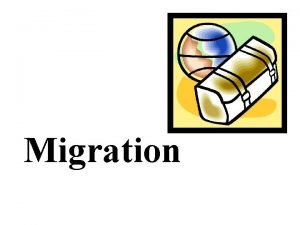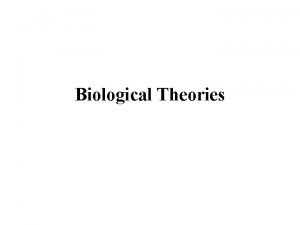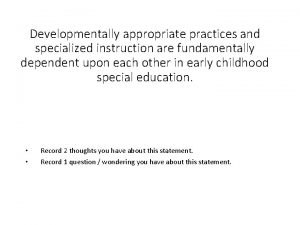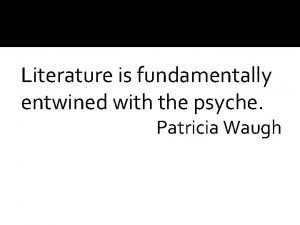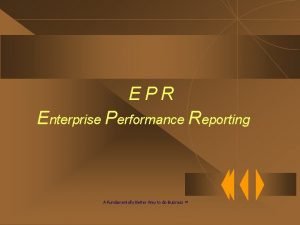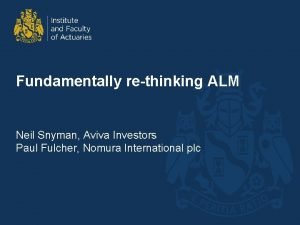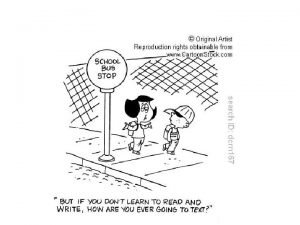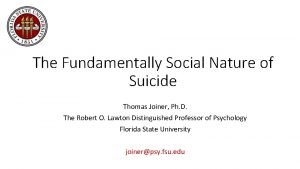Cryptocurrency Intro Cryptocurrency what is it Fundamentally its


























- Slides: 26

Cryptocurrency Intro

Cryptocurrency: what is it? Fundamentally, it’s a ledger. Alice owes Bob $10 Alice owes Charlie $20 Charlie owes Bob $50 Bob owes Deborah $90 Deborah owes Alice $15

Cryptocurrency: what is it? It’s public. Issues that arise: ● Privacy? ● How do we know both parties agree to a transaction? And how do we know people aren’t impersonating others? ○ Digital Signatures -- more on this later! ● How do we know everyone will pay their debts? ○ Don’t allow people to go net negative.

Cryptocurrency: what is it? It’s public. Alice has $100 Bob has $120 Charlie has $50 Deborah has $10 Alice owes Bob $10 Alice owes Charlie $20 Charlie owes Bob $50 Bob owes Deborah $90 Deborah owes Alice $15

Cryptocurrency: what is it? It’s not tied to any other currency. Cornell. Coin Ledger Alice has 100 CC Bob has 120 CC Charlie has 50 CC Deborah has 10 CC Alice owes Bob 10 CC Alice owes Charlie 20 CC Charlie owes Bob 50 CC Bob owes Deborah 90 CC

Cryptocurrency: what is it? It’s decentralized. Alice Charlie Bob Deborah

Cryptocurrency: what is it? It’s decentralized. Issues that arise: ● What is the source of truth? How do we know that everyone has the same ledger? ○ Need to guarantee some kind of consensus. ● How is new money introduced to the system? And when? And to who? ○ “Work” -- more on this later!

Cryptocurrency: what is it? It’s a ledger. It’s public. It’s decentralized. Cornell. Coin Ledger Alice has 100 CC Bob has 120 CC Charlie has 50 CC Deborah has 10 CC Alice owes Bob 10 CC Alice owes Charlie 20 CC Charlie owes Bob 50 CC Bob owes Deborah 90 CC

Digital Signatures

Digital Signatures Goal: ● Identify a particular person digitally ● Verifiable by a third party ● Not forgeable

Digital Signatures Why is this hard? Alice 011101100011101… Alice Bob Alice 011101100011101… Bob “Alice” Charlie

Digital Signatures 1. Key Generator a. Produces a Public Key and Private/Secret Key b. Example: RSA 2. Sign(message, private_key) -> signature a. Not reversible (without private_key) b. Output should appear uncorrelated with input 3. Verify(message, signature, public_key) -> boolean a. Note: doesn’t involve the private key!

Digital Signatures Gen() -> pk, sk Alice Bob Alice: pk Charlie Alice: pk pk

Digital Signatures m pk, sk Alice Sign(m, sk) = s Bob Alice: pk Verify(m, s, pk) = true

Digital Signatures m 2 Alice: pk Bob “Alice” s Charlie Alice: pk Verify(m 2, s, pk) = false

Digital Signatures Cornell. Coin Ledger Alice owes Bob 100 CC Signed by Alice

Digital Signatures Cornell. Coin Ledger Alice owes Bob 100 CC Signed by Alice Alice owes Bob 100 CC Signed by Alice

Digital Signatures Cornell. Coin Ledger 1. Alice owes Bob 100 CC Signed by Alice 2. Alice owes Bob 100 CC Signed by Alice 3. Alice owes Bob 100 CC Signed by Alice 4. Alice owes Bob 100 CC Signed by Alice 5. Alice owes Bob 100 CC Signed by Alice

Digital Signatures: Implementation ● Implementation is for fun! ○ Presenting a (simplified) version of the RSA implementation ● Prime numbers ● Modulo arithmetic ○ ○ ○ Reminder: this is getting the remainder after division 10 mod 4 = 2 15 mod 5 = 0 ● Goal: Find e, d, n, such that (me)d ≡ m (mod n) ○ Should also be tricky to determine d given e, n, m ● Examples taken from Wikipedia

Digital Signatures: Key. Gen Implementation ● Choose two prime numbers: p, q ○ ● ● Should be chosen randomly Compute n = pq Compute λ(n) = LCM((p-1, q-1)) Choose 1 < e < λ(n), such that e and λ(n) are coprime Solve for d: d*e = 1 mod λ(n) ● Public key: (n, e) ● Private key: (n, d)

Digital Signatures: Implementation ● Reminder: Find e, d, n, such that (me)d ≡ m (mod n) ● Public key: (n, e) Private key: (n, d) ● Sign(m, sk): md mod n ● Verify(m, s, pk): se mod n == m

Digital Signatures: Key. Gen Implementation Example ● ● ● p = 61, q = 53 n = pq = 61*53 = 3233 λ(3233) = LCM(60, 52) = 780 Choose e = 17 Solve for d: d*17 = 1 mod 3233 → d = 413 ● Public key: (3233, 17) ● Private key: (3233, 413)

Digital Signatures: Example pk = (3233, 17) sk = (3233, 413) Alice Bob Alice: (3233, 17) Charlie Alice: (3233, 17) pk: (3233, 17)

Digital Signatures: Example m = 65 pk = (3233, 17) sk = (3233, 413) Alice Sign(m, sk) = md mod n 65413 mod 3233 = 588 Bob Alice: (3233, 17) Verify(m, s, pk) = (se mod n == m) 58817 mod 3233 == 65

Public/Private Key Encryption pk = (3233, 17) sk = (3233, 413) Alice c = 2910 Bob Alice: (3233, 17) m = 92 Decrypt(c, sk) = cd mod n 2910413 mod 3233 = 92 Encrypt(m, pk) = me mod n 9217 mod 3233 = 2910

Digital Signatures Unanswered questions: ● Why on earth does this work? ● How do Bob and Charlie know that the public key they received is actually from Alice? ○ ○ Practically… not a technical solution. Certificate Authorities do the job. Can the blockchain be used for this?
 Tzarget
Tzarget Computer security 161 cryptocurrency lecture
Computer security 161 cryptocurrency lecture Fundamentally flawed security mechanism
Fundamentally flawed security mechanism Fundamentally toys
Fundamentally toys When a train increases its velocity its momentum
When a train increases its velocity its momentum Its not easy but its worth it
Its not easy but its worth it Weather sunny cloudy rainy windy
Weather sunny cloudy rainy windy If its a square it's a sonnet summary
If its a square it's a sonnet summary The emigree poem structure
The emigree poem structure Its halloween its halloween the moon is full and bright
Its halloween its halloween the moon is full and bright Introduction to visual basic programming
Introduction to visual basic programming Hook for expository essay
Hook for expository essay Theories of meaning
Theories of meaning Alter introduction template
Alter introduction template Eva och adam intro
Eva och adam intro Change management process
Change management process Rethinking business process
Rethinking business process Bomb calorimetry equation
Bomb calorimetry equation Intro to group work practice
Intro to group work practice La princesse de cleves intro dissert
La princesse de cleves intro dissert Mumintest
Mumintest The xx intro live
The xx intro live What is organic chemistry
What is organic chemistry All matter is in constant motion
All matter is in constant motion Intro
Intro Makeup intro
Makeup intro Lynda intro
Lynda intro
